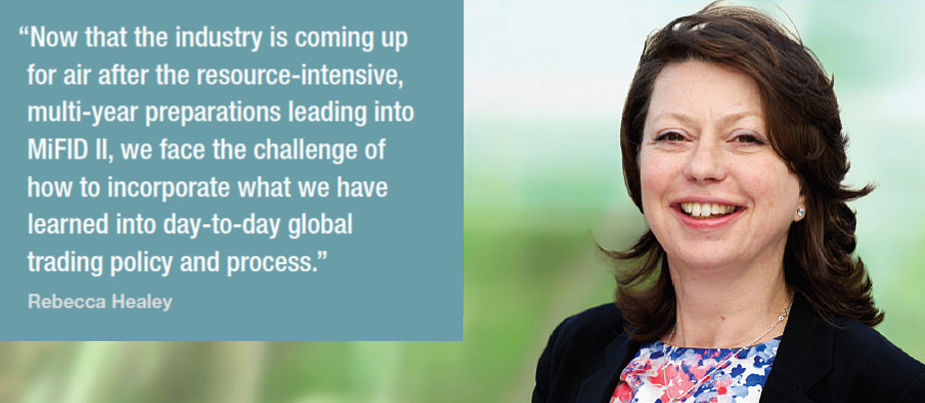A global gold standard of best execution – moving beyond MiFID II
By Constantinos Antoniades, Head of Fixed Income, and Rebecca Healey, Head of EMEA Market Structure, Liquidnet.
The introduction of MiFID II in Europe has brought the discussion around best execution back into focus. Even though MiFID II is a European regulation, the commercial importance in demonstrating a firm’s added-value in terms of execution on behalf of their clients is transforming a local regulation into a global challenge. As asset managers look at how they can best service their end investors, we are witnessing a move towards a standardised best execution process at a global level, irrespective of region. This creates the opportunity for differentiation in an increasingly competitive marketplace.

Under MiFID II, asset managers must establish and implement effective arrangements to meet their execution obligations. This must be communicated to their clients in the form of a best execution policy, and performance must be tracked and monitored. According to the European Securities and Markets Authority (ESMA), investment managers also need to implement a process which develops performance insights into an evolving enhancement of execution processes. This will require firms to monitor not only the quality of execution received, but also the appropriateness of their execution arrangements and policies on an ex-ante and ex-post basis, to identify circumstances under which changes may be needed. ESMA has been clear in what it wants to see from asset managers in terms of policy, process and enhancement. However, it is much less prescriptive when it comes to specific components. We think, rightly so. Each asset manager is required to make its own decision in how it chooses to meet these objectives, provided it can demonstrate the effectiveness of the policies and the processes they have put in place.

Now that the industry is coming up for air after the resource-intensive, multi-year preparations leading into MiFID II, we face the challenge of how to incorporate what we have learned into day-to-day global trading policy and process. Firms need to find a way to move from merely demonstrating that they got the best possible price, to implementing a policy and process that can continuously enhance their execution as well as adapt to the changing liquidity landscape. This is a key distinction between the pre-MiFID II world and where we are now. In short, previous execution strategies and processes in liquidity may fall short of the best execution policy expectations set by ESMA.
One size does not fit all
In an asset class as diverse as fixed income, there is no single best execution process and policy that can capture all types of securities, especially when considering the different pricing transparency and liquidity profiles. For example, the best execution policy for a G7 government bond will look very different to that for a high yield corporate bond or a credit derivative. For such policy to work, therefore, it must account for the nuances and market structure of each separate sub-asset class, as well as empower the trader to use the policy and available tools to generate alpha as part of the execution process.
One key aspect of a best execution policy is that it must demonstrate that the firm has taken all appropriate steps, including data gathering and an audit trail, to build the case and justify decision-making.
One obvious issue is that the quality of pre- and post-trade data is often poor. For example, ESMA has determined that only 220 of the 71,000-strong universe of corporate bonds assessed* were sufficiently liquid to be subject to MiFID II’s real-time transparency requirements. This means that the amount of new data sets to be available from MiFID II will be of marginal practical value to the market, as data will either only be available for highly liquid bonds where price discovery is not an issue, or on a delayed, post-trade basis, making the data less valuable to investment managers. Nevertheless, independent of regulatory initiatives, the quality of pre- and post-trade data will steadily improve as venues and data aggregators continue to gather relevant data sets and package them in a consumable manner to asset managers, to meet the market’s needs.
The challenges around accurate Transaction Cost Analysis (TCA) for less liquid, fixed income markets are relevant too. TCA works well for liquid and quoted markets, but it is less of a holy grail in most fixed income instruments, especially outside the most liquid government bonds. Generally, most fixed income asset classes have little real-time, pre- or post-trade transparency, and no exchange-like quotation systems. In addition, the quality of data within a given asset class, such as corporate bonds, varies dramatically based on the liquidity of specific instruments. In short, data quality makes a potential TCA report less reliable and less accurate, especially when trying to interpret a single result. Nevertheless, even if TCA should not be relied on as a standalone basis, it can still play an important role as part of a comprehensive, best execution policy, especially assessing quality of execution around different venues and being able to adjust the policy moving forward (another MiFID II requirement).
Moving to a global gold standard of best execution
As European market participants ease into the post-MiFID II world, the entire industry needs to reflect on what this regulation set out to achieve and how it can all benefit from some of these changes. A global, gold standard of best execution process and policy will require asset managers to combine access to different data sets with an audit trail of time-of-execution, documentation of the decision-making process, and importantly, the ability to access different types of liquidity, including liquidity from different venues.
The trading desk of the future will need a system that digitally captures every step the team has taken in handling an order. Effective Order Management and/or Execution Management System (OMS/EMS) capabilities will help asset managers handle orders more efficiently. Such systems are increasingly becoming the central nervous system in the process of helping traders collect and record data for best execution, and the ability to direct orders to the most suitable venues taking into account the liquidity of the bond and the size of the order.
Execution will be documented using a digital audit trail, showing the steps that an order took in line with the best execution policy. Equally importantly, this same best execution policy and process should, in turn, empower the trading desk to deliver more alpha by having greater insight into the liquidity profile of the bond, as well as deliver transaction cost savings and reduce market impact.
Next steps. How should best execution policy evolve at an industry level?
Best execution policies are becoming a living document. Looking ahead, we can expect to see them evolve in several ways:
- There will be a greater focus on the need to access natural liquidity which saves transaction costs and reduces market impact. It will be increasingly hard for an investment manager to be able to satisfy best execution without including access to natural liquidity as part of their policy, at least for certain types of orders.
- Modern best execution policies will require access to a diverse ecosystem to support price formation and the best outcome on a process basis.
- After establishing the quality of execution that should be achieved, it must then be delivered. Being able to use data and intelligence to best assess the venue which delivers an optimal combination of price, size, and minimum market impact will likely be the next stage of differentiation by asset managers.
- The combination of proliferation of electronic trading and the availability of more sophisticated data sets will likely lead to more execution automation and intelligent auto-routing – expect to see both in the more sophisticated best execution policies in the near future.
Some investment managers will see their best execution policies as a mere box-ticking and record-keeping exercise; others will see it as an opportunity to differentiate their returns. When combined with data, intelligent tools, and the ability to proactively access electronic liquidity from various venues, a best execution policy can lead to further differentiation between those who make the most out of the changing market structure, and those who don’t. The changes in best execution policies are a real opportunity to empower the trading desk to deliver alpha and better implement their investment strategy. Those who embrace this approach will lead the way.
* https://www.esma.europa.eu/press-news/esma-news/esma-launches-bond-liquidity-system-under-mifid-ii
©Markets Media Europe 2025












